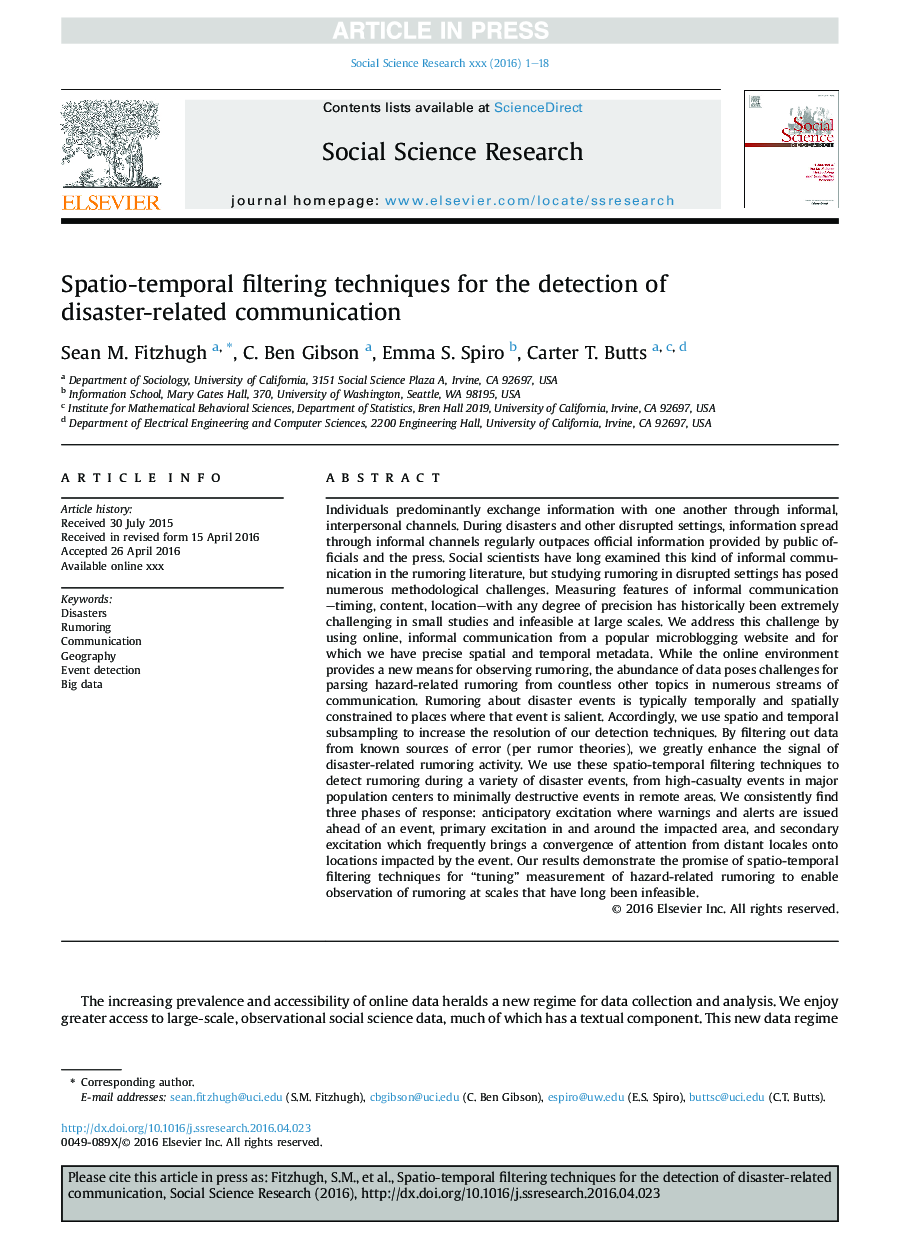| کد مقاله | کد نشریه | سال انتشار | مقاله انگلیسی | نسخه تمام متن |
|---|---|---|---|---|
| 7339076 | 1476116 | 2016 | 18 صفحه PDF | دانلود رایگان |
عنوان انگلیسی مقاله ISI
Spatio-temporal filtering techniques for the detection of disaster-related communication
ترجمه فارسی عنوان
تکنیک های فیلتراسیون فضایی زمانی برای تشخیص ارتباطات مرتبط با فاجعه
دانلود مقاله + سفارش ترجمه
دانلود مقاله ISI انگلیسی
رایگان برای ایرانیان
کلمات کلیدی
بلایای طبیعی، شایعه، ارتباطات، جغرافیا، تشخیص رویداد، اطلاعات بزرگ،
ترجمه چکیده
افراد اغلب با یکدیگر از طریق کانال های غیر رسمی و بین فردی تبادل اطلاعات می کنند. در طول بلایای طبیعی و دیگر تنظیمات متلاشیک شده، اطلاعاتی که از طریق کانال های غیر رسمی گسترش می یابد به طور منظم اطلاعات رسمی ارائه شده توسط مقامات دولتی و مطبوعات را فراتر می گذارد. دانشمندان علوم اجتماعی این نوع ارتباطات غیررسمی را در ادبیات طنزآمیز مورد بررسی قرار دادهاند، اما مطالعهی شایعهسازی در شرایطی که اختلال ایجاد کرده است، چالشهای روششناختی فراوانی را به وجود آورده است. اندازه گیری ویژگی های ارتباطات غیررسمی زمان بندی، محتوا، موقعیت مکانی - با هر درجه دقت، از لحاظ تاریخی، در مطالعات کوچک به شدت چالش برانگیز است و در مقیاس های بزرگ غیر قابل قبول است. ما به این چالش با استفاده از ارتباطات آنلاین و غیر رسمی از یک وب سایت میکروبلاگینگ محبوب که برای ما اهداف دقیق و مکانی فضایی و زمانی استفاده می کنیم، صحبت می کنیم. در حالی که محیط آنلاین ابزار جدیدی برای رعایت شایعات است، فراوانی داده ها چالش هایی را برای تجزیه شایعات مربوط به خطر از مباحث بی شماری دیگر در جریانات متعدد ارتباط برقرار می کند. شایعات در مورد حوادث فاجعه به طور معمول به طور موقت و فضایی محدود به مکان هایی است که این رویداد برجسته است. بر این اساس، ما از نمونه برداری فضایی و زمانی استفاده می کنیم تا رزولوشن تکنیک های تشخیص ما افزایش یابد. با فیلتر کردن داده ها از منابع خطا شناخته شده (در هر نظریه شایعه)، ما به شدت سیگنال فعالیت های شایعه مربوط به فاجعه را افزایش می دهیم. ما از این تکنیک های فیلترینگ فضایی و زمانی برای شناسایی شایعات در حوادث مختلف فاجعه استفاده می کنیم، از رویدادهای شدید تلفات در مراکز عمده جمعیت تا رویدادهای مخرب مخرب در مناطق دور افتاده. ما به طور مداوم سه مرحله پاسخ را پیدا می کنیم: تحریک پیش بینی کننده ای که هشدارها و هشدارها پیش از یک رویداد، تحریک اولیه در اطراف منطقه آسیب دیده و تحریک های ثانویه صادر می شود و اغلب همگرایی توجه از مکان های دور را به مکان هایی که این رویداد را تحت تاثیر قرار داده است، به ارمغان می آورد. نتایج ما نشان می دهد وعده تکنیک های فیلترینگ فضایی برای زمان بندی؟ اندازه گیری شایعات مرتبط با خطر را قادر می سازد که مشاهده شایعات در مقیاس هایی که مدت ها غیرممکن بوده اند.
موضوعات مرتبط
علوم انسانی و اجتماعی
روانشناسی
روانشناسی اجتماعی
چکیده انگلیسی
Individuals predominantly exchange information with one another through informal, interpersonal channels. During disasters and other disrupted settings, information spread through informal channels regularly outpaces official information provided by public officials and the press. Social scientists have long examined this kind of informal communication in the rumoring literature, but studying rumoring in disrupted settings has posed numerous methodological challenges. Measuring features of informal communication-timing, content, location-with any degree of precision has historically been extremely challenging in small studies and infeasible at large scales. We address this challenge by using online, informal communication from a popular microblogging website and for which we have precise spatial and temporal metadata. While the online environment provides a new means for observing rumoring, the abundance of data poses challenges for parsing hazard-related rumoring from countless other topics in numerous streams of communication. Rumoring about disaster events is typically temporally and spatially constrained to places where that event is salient. Accordingly, we use spatio and temporal subsampling to increase the resolution of our detection techniques. By filtering out data from known sources of error (per rumor theories), we greatly enhance the signal of disaster-related rumoring activity. We use these spatio-temporal filtering techniques to detect rumoring during a variety of disaster events, from high-casualty events in major population centers to minimally destructive events in remote areas. We consistently find three phases of response: anticipatory excitation where warnings and alerts are issued ahead of an event, primary excitation in and around the impacted area, and secondary excitation which frequently brings a convergence of attention from distant locales onto locations impacted by the event. Our results demonstrate the promise of spatio-temporal filtering techniques for “tuning” measurement of hazard-related rumoring to enable observation of rumoring at scales that have long been infeasible.
ناشر
Database: Elsevier - ScienceDirect (ساینس دایرکت)
Journal: Social Science Research - Volume 59, September 2016, Pages 137-154
Journal: Social Science Research - Volume 59, September 2016, Pages 137-154
نویسندگان
Sean M. Fitzhugh, C. Ben Gibson, Emma S. Spiro, Carter T. Butts,
